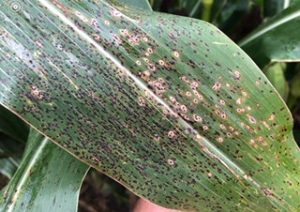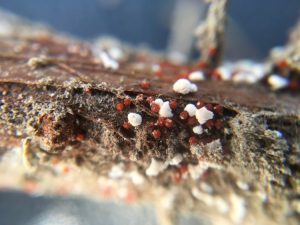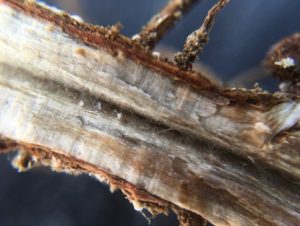Let us know if you see these diseases in Illinois!
There are two, fairly new and / or important diseases to keep an eye out for in 2019. We are actively seeking samples of symptomatic plants for research to help us understand the biology, ecology, and management of these pathogens. If you have a suspect sample, please send to the UIUC plant diagnostic clinic for confirmation (cost will be covered), and or contact me via email, telephone, or twitter.
The first is a disease that we started working on in late 2017- Tar spot on corn. I mentioned in earlier articles that I expect this disease will start to show up more in after canopies close, provided we get sufficient rain. It has been dry, so unless you have seed fields under irrigation, it is likely that tarspot thusfar is extremely low in incidence or nearly absent in your fields in Northern Illinois. Look for raised black spots that typically have a small yellow halo. These spots can expand along the vein, giving them a diamond shape, but also can take various amorphous forms. Make sure you pay attention to the lower canopy.

Below is the current map showing counties where we have confirmed the presence of tar spot in at least one field. If your county is in this region of the state, ensure that you are keeping an eye on your crops and their growth stage. There is still a fair amount of corn that has yet to tassel and plenty of crop development that needs to take place before the season is finished.

The second disease is Red crown rot on soybeans. This disease is something we want to keep an eye on because it is new, it shouldn’t be here, and it can look very similar to Sudden Death Syndrome. Red crown rot likes it warm and wet. The fungus that causes this disease colonizes the roots of the plant, and produces a toxin that accumulates in the foliage, typically after R3. This results in interveinal chlorosis that resembles SDS, or other diseases such as brown stem rot, or stem canker. As the plant nears senesce, the fungus will produce red fungal structures at the base of the stem that give the disease it’s name. When you split the stems roots will often be black and rotted and the center pith of the lower stem will have a grayish appearance. This disease caused significant losses in a field near Pittsfield last season, so those in that area should pay particular attention for this one (but so should everyone!)







